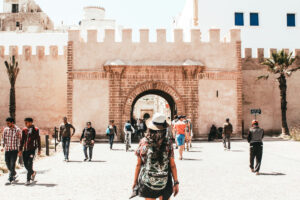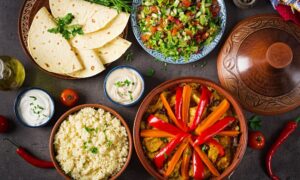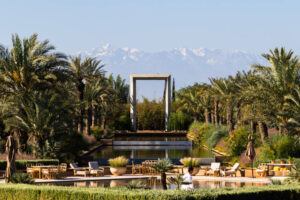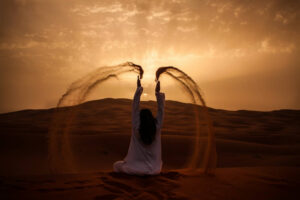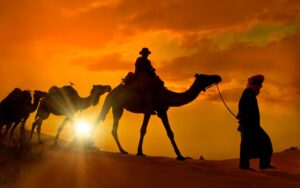Location, Landscapes, and Weather Conditions

Morocco is an African country occupying the northwest corner of the continent. It is the closest African country to Europe, with only 14.5 kilometers (9 miles) of sea separating it from Europe. The kingdom has two coastlines, one on the Atlantic Ocean to the west and the other on the Mediterranean Sea to the north. East of the country lies Algeria, and to the south is Mauritania.
Morocco is known for its landscape diversity and natural beauty. You are wrong if you think it’s just desert and camels here. The country shares extensive coastlines to the north and west, while the interior is home to the famed Atlas and Rif Mountains. Further south lies the stunning Sahara Desert. If you travel across Morocco, you will also come across flatlands used for agriculture, forests of olive trees, and abundant wildlife.
Morocco has a four-season climate, with distinct weather patterns throughout the year. During winter, the northern and middle areas experience wet and snowy conditions. Temperatures can dip as low as -6°C (21°F), particularly at night. However, when it’s not snowing or raining, the weather becomes sunny and warm, with daytime temperatures reaching as high as 20°C (68°F).
Summertime temperatures can rise dramatically to 40°C (104°F), especially in inland areas. During this time, many Moroccans flock to coastal cities to enjoy their vacations by the beach, where it’s more relaxed and breezy.
As usual, autumn and spring in Morocco bring warm to mild temperatures, with highs reaching up to 28°C (82°F).
The Moroccan Sahara Desert is known for being sunny and hot all year round. It is best to plan a visit in winter or spring when temperatures are slightly more relaxed. However, if you plan to go during the summer, staying in coastal cities like Laayoune and Dakhla is recommended to avoid the extreme heat.
Culture and Religion in Morocco

Morocco has a population of Berber and Arab descent. The Berbers were the original inhabitants who lived in the Atlas Mountains area. In the 7th century, The Arabs arrived from the Arabian peninsula during the Muslim conquest of North Africa. This mixture of races resulted in a diverse and rich cultural heritage. In the 20th century, Morocco was conquered by France and Spain, and its proximity to Europe further enriched its culture, making it even more diverse. Today, every part of Morocco has developed its unique music, food, and customs that distinguish it from other regions.
This cultural diversity doesn’t extend to religion, as 99 percent of Moroccans practice Islam. This religion has a significant impact on the country’s traditions. The way people dress, their holiday celebrations, and family values are all based on Islam. As soon as you arrive in Morocco, you will notice various aspects related to Islam, such as mosque minarets and the five times daily Islamic calls for prayer.
Also, don’t expect to be shut down as soon as you set foot here, as the religion calls for tolerance and acceptance of differences. You will be surprised by how generous and hospitable these people are.
Languages Spoken in Morocco

The official language spoken in Morocco is Darija or Moroccan Arabic, a blend of Classic Arabic, Berber, French, and Spanish. Berbers, the indigenous people of Morocco living around the Atlas Mountains, speak Berber in addition to Darija. French is the most commonly taught foreign language in Moroccan schools. However, Spanish is more prevalent in the northern part of the country due to the geographical proximity to Spain and the effects of Spanish rule.
English, on the other hand, is the second most commonly taught foreign language in Morocco. With the increasing exposure to social media, it has become more popular among Moroccans, especially the younger generation. They can communicate reasonably well in English. However, older people still rely on their rusty French to interact with foreigners.
Generally, when traveling to popular tourist cities in Morocco, English is commonly used in accommodations, restaurants, and shops, making it easy to communicate. However, if you plan to explore the country’s smaller towns and villages, it is recommended that you brush up on your French. Additionally, knowing some Spanish would be very useful if you visit the country’s northern parts.
Here are a few Moroccan Arabic words and phrases to help you get by and interact with locals:
|
English |
Darija (Moroccan Arabic) |
| Yes | Ah |
| No | La |
| Me/I | Ana |
| You | Nta (male); Nti (female) |
| OK | Wakha |
| Hello | As-salamu alaykum (peace be unto you); you respond by saying – Wa-alaykumu s-salam (and unto you peace) |
| Hi | Salam |
| Good morning | Sbah el-khayr |
| How are you? | labas? or Labas alik? |
| What is your name? | Ashnu smiteek? |
| My name is … | smiti … |
| Nice to meet you | M’sharfeen |
| Goodbye | Besslama |
| Good | Mazyan |
| A lot/very/so much | Bez’zef |
| Beautiful | Zween |
| You are very handsome | Nta zween bez’zef (male) |
| You are so pretty | Nti zweena bez’zef (female) |
| I’m hungry | Ana ji’aan |
| I’m full | Ana shba’at |
| This is delicious! | Had shi bneen! |
| café/Coffee | El-Kahwa |
| Water – I want water | El-maa – B’gheet el-maa |
| Food – I want to eat | El-makla – b’gheet nakol |
| Bread | El-khobz |
| Please | Afaak |
| Thank you | Shokran |
| Yes, please | Ah afaak |
| No, thank you | La shokran |
| You are welcome | Ma’rrehba |
| No problem | Mashi mushkil |
| Excuse me!/I am sorry! | Smah lia! |
Moroccan Currency

The local currency in Morocco is called the Dirham (MAD), which is made up of 100 local centimes (or cents) and goes for roughly 10 Dirhams per 1 US Dollar, 11 Dirhams per 1 Euro, or 12.5 Dirhams per 1 British Pound. The Moroccan Dirham is a closed currency, which means you can’t get a hold of it outside the country.
You can easily change money in Moroccan cities or towns at banks or Bureaus de Change. However, it’s not advisable to do that at airports or ports as exchange rates are low there. And if you have to, change only the amount you will need. You can also withdraw money from ATMs using a debit or credit card for 35 Dirhams (3.5 USD).
Hotels, restaurants, and some established shops will accept your debit or credit card, whereas small shops, cabs, vendors, and food stalls will not. Therefore, it is essential to have cash with you when traveling around Morocco. A balance of 100 US Dollars in your wallet is sufficient to cover your expenses for one day since things here are more expensive than expected. Also, when traveling back to your home country, there is no point in bringing Moroccan currency back with you as it will be useless.
In Morocco, four bills and five leading coins are used as currency. The bills include a purple 20 Dirham bill, a green 50 Dirham bill, a light brown 100 Dirham bill, and a blue 200 Dirham bill. The coins include a 0.5 Dirham coin, a 1 Dirham coin, and a 2 Dirham coin, all in silver, a silver 5 Dirham coin with bronze on the inside, and a silver 10 Dirham coin with bronze on the outside.
Safety in Morocco

Morocco is a kingdom run by King Mohammed VI and an independent government elected every five years. Both entities are doing a great job, as the country has witnessed much development in recent years. The kingdom has been politically stable, unlike other neighboring North African nations that have seen many protests against their governments in the last decade. The government is also making significant efforts to attract more tourists by providing safety, supporting local and international investments in tourism, and keeping tourist attractions.
As a result of this wise governance, Morocco has been a safe country to travel to, proven by the yearly number of tourists the government receives. However, that does not mean you should not be careful and respect the local customs and traditions. Like any other famous tourist destination, you will undoubtedly encounter many scammers and tourist traps in Morocco. And to make things easier for you, here are some tips for a safe and delightful trip to the country:
- Don’t carry large amounts of money or valuables.
- Avoid quiet areas in large cities like Casablanca and Fes, particularly after dark.
- Always watch your belongings at the beach or in crowded areas.
- Beware of aggressive begging around ATMs and tourist hotspots.
- Avoid hiring unlicensed tourist guides; if you have to, try agreeing on a specific price beforehand.
- Hiking the Atlas Mountains is better done with a professional guide; avoid wild camping.
- Morocco is a Muslim country, so act accordingly and avoid offensive actions such as public displays of affection. The same goes for LGBT+ travelers.
- For women travelers to avoid unwanted attention from men, consider wearing loose-fitting clothes covering your arms, legs, and chest.
- Ramadan is a holy month for Muslims; therefore, avoid eating, drinking, smoking, or chewing gum publicly during the daytime as it’s considered an offense.
- Don’t carry illegal drugs, as you could get arrested.
- Drink alcohol only at licensed places such as hotels, bars, restaurants, and tourist areas. It’s illegal to drink alcohol in the street.
- As a conservative society, Moroccans don’t like being displayed on YouTube or other social media platforms, so avoid filming in public places or ask for permission before you do that.
- Get authorization before you bring your drone to Morocco, as it might be confiscated upon arrival.
- Avoid taxis or lifts that are bookable via mobile apps, as the authorities have yet to legalize them. Use Grand or Petit Taxis.
- Before taking a taxi, negotiate the fare or ask for the tariff list beforehand to avoid overcharging.
- Also, when buying gifts or souvenirs, ensure you haggle for prices, as vendors sometimes tend to overcharge tourists.
While Morocco is generally safe, tourists may fall prey to scams that are common in all tourist countries. However, vigilance can help you avoid such situations and enjoy the country’s beauty.
Dress Code in Morocco
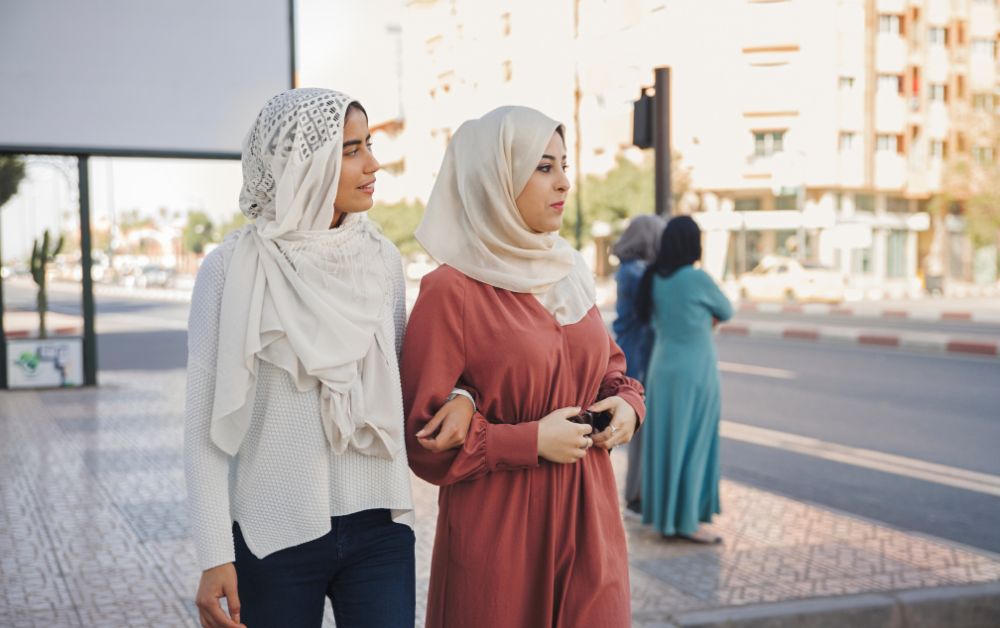
This topic is more important to female travelers than to male travelers. For men, there are no restrictions on clothing in Morocco. However, women should dress modestly to respect local customs and avoid unwanted attention. As previously mentioned, Morocco is a conservative Muslim country where women wear clothing that covers their hair and body.
While traveling around Morocco, there are no hard and fast rules or restrictions regarding how women should dress. You may encounter local women and girls dressed in clothing that does not cover their entire bodies. This is expected as the country is open to the world and embraces diversity.
However, most local women still follow Islamic teachings and dress modestly. Therefore, it’s important to remember that our travels are not just about exploring new sights and cultures but also about respecting those cultures and finding ways to coexist despite our differences.
It is important to note that locals consider covering your breasts and stomach area as a sign of respect. Moreover, loose pants or baggy jeans are standard here and help keep your body cool in hot weather. Also, if you prefer long dresses, that will work perfectly. Keep in mind that these types of clothing not only align with cultural norms but also protect you from unwanted attention.
The Best Time to Visit Morocco

Morocco is a popular tourist destination throughout the year and has much to offer regardless of when you visit. However, the best time to visit the country depends on your interests and holiday preferences. For example, if you plan to visit the Moroccan Sahara Desert, there is a specific time of the year when it’s ideal. Similarly, if you want to enjoy nature and hiking, this must be done during a particular time of the year.
Therefore, to help you plan your trip and decide on the best time to visit the country, here is what you can do in Morocco each season.
- Summer
As stated in this article, summer months in Morocco tend to be extremely hot, particularly in inland cities. However, it is still a great time to plan a summer vacation in one of the many coastal cities such as Tangier, Rabat, Essaouira, Agadir, or Taghazout. For a fantastic beach experience, it is best to avoid northern cities like Tetouan and El-Hoceima or cities in the middle like Casablanca, Mohammadia, and El-Jadida, as they are locals’ favorite beach destinations.
You can also explore inland towns like Marrakech, Fes, or Chefchaouen and enjoy their balmy evenings and lively nights. However, we advise against hiking or sightseeing in the late mornings or afternoons due to soaring temperatures.
- Autumn
The autumn season in Morocco is ideal for a late summer vacation, as schools reopen in September and coastal cities become less crowded. During this time, temperatures remain warm enough to enjoy the beach, explore the country, and do some hiking.
- Winter
Morocco can be an excellent destination for travelers who want to escape the harsh winter weather in Europe or North America. Even during winter, the country’s moderate daytime temperatures make it ideal for exploring its exotic cities. Although you may experience rain or snowfall in some towns in the Atlas Mountains, the weather is still warm. Additionally, since it is the school season and people are working, it could be a perfect opportunity for a quiet vacation.
- Spring
Spring is the perfect time to explore all that Morocco has to offer, including the Sahara Desert, where you can discover the golden dunes and the nomadic life of the Sahara people. From mid-March to May, the temperatures in the desert are pleasant, although chilly at night, which allows for enjoying campfires and sleeping soundly through the night.
If you are a hiking and nature lover, this is also the perfect time to enjoy the beauty of the Atlas Mountains. You can also take things up a notch and challenge yourself to climb Mount Toubkal (4167 meters), the highest mountain in North Africa.
Where to Stay in Morocco
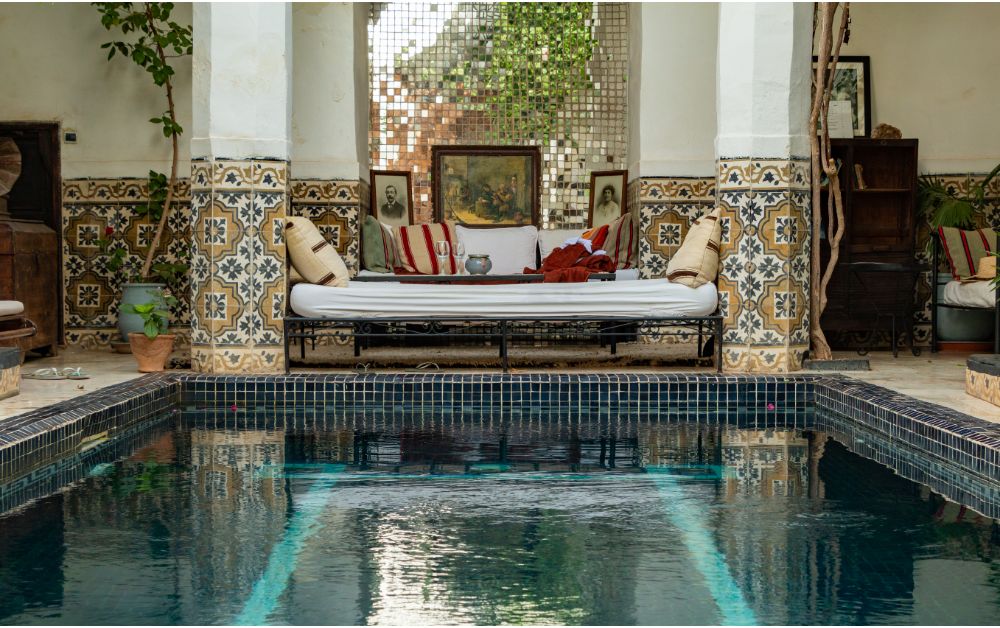
If you plan to visit Morocco for the first time, there’s no need to worry, as the country caters to different tourist accommodation preferences. From luxurious five-star hotels and traditional Moroccan riads to cozy and friendly guesthouses, you will find a place that suits your budget and holiday needs.
And even if you find yourself in a small town or village without commercial accommodation, don’t worry; you can knock on any family’s door, and they’ll welcome you to stay for the night. Moroccans are known for their kindness and hospitality, and they will share all they have with their guests without expecting anything in return.
Get Around in Morocco

Morocco is a relatively developed country with many transport options available to locals and tourists. Several options exist whether you’re traveling within a city or from one town to another. Here is a comprehensive guide on how to get around in Morocco.
- Petit Taxi
Petits or small taxis are commonly used to transport people within urban areas. Each cab can accommodate up to four people – three passengers and a driver. The color of these taxis varies from one city to another.
Unfortunately, they are not bookable online, so you must hail a cab on the street. Alternatively, you can get a taxi driver’s phone number and call them when you need a ride, although this may cost you more. Also, if you’re staying in commercial accommodation, the receptionist can call a taxi to take you to your destination or back to your accommodation.
Petits taxis in small towns have a fixed tariff, while in larger cities, they use a meter. When there are vacant seats, drivers may pick up additional passengers heading in the same direction as the first passenger or closer.
- Grand Taxi
Grand taxis are a mode of transportation that can take you from one town or district to another in large cities. They are generally larger than petits taxis and can accommodate up to six passengers along with the driver. The colors of grand taxis vary depending on the province.
Unlike petits taxis, grand taxis do not use a meter to determine the fare. Instead, they charge a fixed tariff based on the distance and destination. You can also book the entire cab and pay the total amount six passengers usually pay. If you intend to go somewhere not on the cab’s usual route, you can negotiate the fare in advance with the taxi driver.
- Train
Traveling around Morocco can also be done by train. The country has several train stations located in the central and northern regions. Additionally, Morocco boasts Africa’s first and only bullet train that runs from Tangier to Casablanca and will soon begin operating between Casablanca and Marrakech. Unfortunately, the southern parts of Morocco and the Sahara cannot be accessible by train.
Major cities such as Casablanca, Marrakech, Rabat, Tangier, and Fes are connected by railroad, making it convenient to visit them all. Moroccan trains offer a comfortable ride, and you can always upgrade to first class for an even better experience. Also, traveling by train here can be cheaper than grand taxis and faster and more relaxed than taking a bus.
Book your ticket online:
- Bus
Buses are an excellent option for travel in Morocco and are accessible in any small city or large city. The country has two types of bus companies: local companies for residents and larger ones for tourists and wealthy locals. Premium bus companies offer air conditioning, Wi-Fi, food, comfortable seating, and scenic views. In contrast, local designated companies are generally cheaper but still provide a comfortable ride with air conditioning and sometimes Wi-Fi.
CTM, Supratour, and SATAS are Morocco’s three leading premium bus companies. Traveling with one of these companies can make the ride feel smoother and more relaxed. However, it’s worth noting that some small towns are not included on these companies’ destination lists. Therefore, it may be necessary to take a ride with a local bus company.
- Tramway, Busway, and BRT Marrakech
After installing tramways and busways, getting around the large cities of Casablanca and Rabat is also easy. In fact, the Rabat Tramway connects the twin cities of Rabat and Salé. These two means of transportation make navigating the cities easier and faster. They are also cheaper, costing less than one US dollar per ride, and environment-friendly, operating exclusively on electricity.
RBT Marrakech is another means of transportation that makes navigating the busy city of Marrakech easier. These buses offer a service similar to trams or subways but cheaper. They also signify the city’s environmental commitment after hosting COP22, 2022 Conference of the Parties on climate change.
- Plane
Domestic flights are another efficient option to get around the country, especially for cash-rich and time-poor people. Morocco has several airports scattered all over the country. And even if you intend to visit the Moroccan Sahara Desert, you can catch a flight to Er-rachidia, Layoune, or Dakhla. Domestic flights are available daily and provided by local airlines, Royal Air Maroc, and the low-cost carrier Air Arabia.
This option is quite popular, even among locals, when traveling towards the southern or eastern areas of the country. Flying to one of these destinations can take one to three hours; however, traveling by bus might take a whole day. This costs way more than taking a bus but saves time and effort.
- Car rental
Renting a car is the best way to travel in Morocco as it offers flexibility and freedom to explore any place according to your preferred schedule. However, it is essential to remember that driving in Morocco can be risky as many drivers and pedestrians don’t follow the road rules strictly.
Also, while driving through the country, you may encounter random police checkpoints. These checkpoints have the authority to issue fines for even the most minor mistakes, which can be frustrating sometimes. Consequently, only a few tourists opt for this option, but it’s still worth trying if you are up to the challenge.
Food in Morocco

Morocco is known for its delicious, worldwide famous food. The country’s rich cuisine offers a variety of traditional and modern dishes that will dazzle your senses. When you are here, take advantage of the opportunity and try as much local food as possible.
If you are unfamiliar with Moroccan food and don’t know where to start, here is a detailed article about the top ten must-try Moroccan dishes.
Shopping in Morocco

When you first step into an old medina in Morocco, you will be amazed by the vast array of handcrafted goods on display. Most of these goods are handmade and unique, making it challenging to resist bringing some back home as souvenirs. While exploring the narrow alleyways of these old medinas, you may even see artisans crafting something special that you’ll want to buy directly from them.
If you are planning a trip to Morocco, remember that shopping is integral to the experience. However, shopping in Morocco can be tricky, as there is a risk of being scammed if you are unfamiliar with local practices. Therefore, knowing how things work here is vital to avoid unpleasant experiences.
It’s worth noting that local shops in this area do not display price tags on their products, which can be confusing for someone unfamiliar with this type of commerce. In addition, the price of a product can vary depending on the buyer. If the buyer is a local, the price may be regular but still negotiable. However, the cost can be substantially inflated if the buyer is a tourist.
It sounds scary, but there is nothing to worry about. We will give you some tips to help you get the best products for decent prices. After all, these handcrafted goods still cost less here than if they were sold in a shop in Europe or North America.
Tip number one: Take it easy! Many shops sell the same goods you are interested in.
Tip number two: Check prices at different shops. Some vendors may offer reasonable prices without requiring negotiation.
Tip number three: Put your haggling skills into use. Sometimes, you can get items for half the price or even less.
Haggling, or negotiating prices, is common in Moroccan culture and often used by locals. It is perfectly acceptable to bargain for the cost of a product before purchasing it. In fact, it is considered an enjoyable part of the shopping experience in Morocco.
Alcohol in Morocco

If you search the internet, you may come across many conflicting opinions about alcohol consumption in Morocco. Some rely on hearsay, while others make a big deal out of it. Morocco is indeed a Muslim state, but it is also a country that is open to the world and embraces differences, as highlighted in this article. Therefore, it is acceptable to consume alcohol in Morocco as long as you adhere to specific guidelines.
You may be surprised if we tell you that the country produces its own liquor and a significant portion of the population, especially men, consumes alcohol. As a tourist, you also can drink alcohol when you visit the country, but you have to follow this guide if you want to avoid any legal consequences.
Option one: Consume alcohol at your hotel. Most commercial accommodations have licenses to serve alcohol. You can also check if they do before booking your stay.
Option two: Order alcohol at a licensed restaurant, bar, or club.
Option three: Purchase alcohol at a liquor store/shop. These can be found in all tourist cities. They also have a wide range of options to choose from.
Option four: Buy alcohol from a supermarket like Acima or Carrefour. However, these places have limited options because they sell primarily to locals. Also, the liquor is not on display here, so you must go to a separate section to order it.
These are the only legal options for drinking alcohol in Morocco. Although other possibilities exist, they are illegal and can lead to severe consequences. Also, when purchasing alcohol from a liquor store or supermarket, it cannot be displayed to the public or consumed on the streets. It must be done discreetly, and once you reach your place of stay, be it a flat, house, or hotel, you may enjoy it however you prefer.
Partying and Nightlife in Morocco
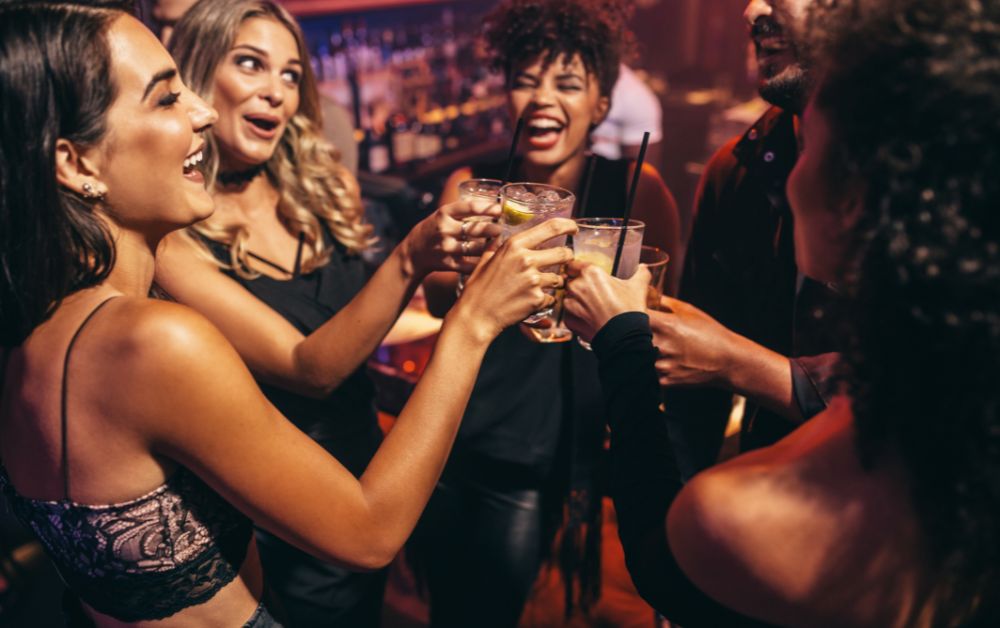
If you are allowed to drink alcohol in Morocco, then you can also enjoy nightlife and partying. The country has various casinos, nightclubs, and dance venues in all the famous tourist cities. However, cities like Marrakech, Agadir, and Casablanca are the main hot spots for these activities.
Although it may seem unusual for a Muslim nation, the country allows for differences and permits individuals to enjoy themselves as long as they respect public norms. If you visit these places, you will be surprised by the many locals who love to party and have fun.
Morocco’s diverse nightlife scene will also surprise you with its various activities. Morocco offers a wide range of options for those who seek a night out. You can have a fun night out if you prefer a relaxed and elegant atmosphere with traditional local music and shows. On the other hand, if you want to experience a loud and wild night with a mix of modern regional and international music, Morocco has that, too.
If you are looking for recommendations, check out these Morocco nightlife activities.
A Female Tourist in Morocco

If you want to visit Morocco and are still determining how the experience will turn out for you as a female traveler, don’t worry too much. Apart from some cat-calling and tourist traps, the country is safe whether traveling solo or with company. Also, a little precaution is always needed when traveling around a foreign country, but that applies to both genders.
However, one thing that female travelers suffer from is unwanted attention from local men. This is a common occurrence and can be quite bothersome at times. The fact that local women also suffer from such attention shows that men here tend to cat-call any woman that attracts them. But this does not mean they would stalk you or physically harass you in any way. In fact, the attention gets stale very quickly.
Unfortunately, you can do nothing to avoid this apart from ignoring it. Also, some female travelers reported receiving less unwanted attention when they traveled around the country with other men or wore scarves in crowded places.
If you are a non-Muslim female traveler planning to visit a mosque in Morocco, please keep in mind that it can be challenging. However, some mosques, such as the Hassan II mosque in Casablanca, allow tourists to enter outside prayer times. But as a woman, you must dress appropriately. This means covering your arms, legs, and hair with a scarf. Revealing clothing is not allowed inside the mosque.
Generally, Morocco is a popular tourist destination that attracts many visitors yearly, particularly women. The locals have gotten used to seeing tourists all the time, and if you respect their cultural norms and customs, you will be welcomed and treated with respect.


